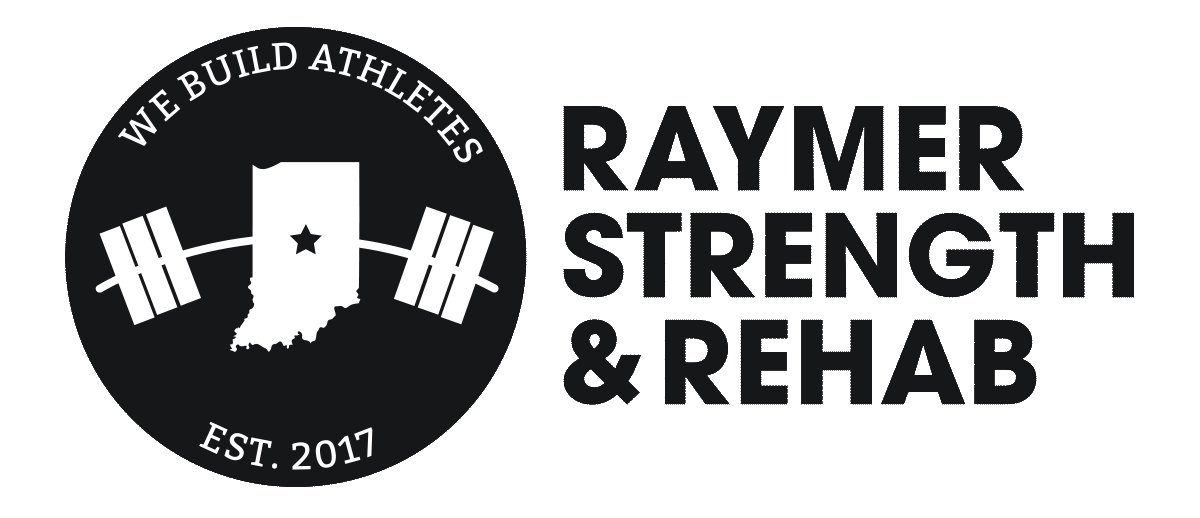Strength training during middle school is a performance hack
Strength training will not stunt a child’s growth.
There. Said it. Got it out of my system.
If you still believe that myth from the 80s and 90s, read this from the NSCA. Research has documented over and over that strength training is actually beneficial for kids when done right.
It’s our goal to develop strong and resilient young athletes that can maintain fundamental movement patterns during the demands of their sports. We want them to learn how to become better movers, and therefore, better athletes.
Let’s dig into why strength training at this age is such a performance hack!
Middle school athletes work on mobility and stability at Raymer Strength.
It’s the ideal age for motor skill learning
Resistance training in children and adolescents is safe– and super effective. A 2011 review found that as a result of resistance training, pre-pubescent and early pubescent youth achieved motor skill improvements approximately 50% greater than adolescents (1).
In fact, children can be ready for resistance training before age 10. But in our opinion, children that young are better served playing with their peers and trying multiple sports to just have fun.
So… parents of 4th-8th graders, listen up. RIGHT NOW, you have the best chance to maximize motor skill development through a good resistance program.
You need a coach that understands how children’s’ anatomy and physiology are different from adolescents’… and how adolescents are different from adults. They need to understand how cognitive development, growth, and maturation at different stages influence a safe and effective training program.
A good program will assess and improve how the body bends and moves, teach fundamental athletic positions, strengthen these positions, work through full ranges of motion, and increase kids’ body awareness/proprioception.
Besides strength training, maximize this ‘golden age’ of motor learning by encouraging your kids to get out and play and try new sports. This benefits their emotional and mental development, in addition to their physical development.
Middle school athletes working on fundamental movements
It decreases chances of injury
More athletes are specializing in sports at a younger ages, and both non-contact and overuse injuries are on the rise. If multiple sports is not in the cards, we need to expose these kids to a good resistance program to try and mitigate chances of injury.
Half the battle of having fun in sport and becoming a better athlete is staying healthy and able to play. Strength training for youth athletes has been recommended in many published studies to decrease the chances of non-contact injuries. (refs 2, 3, 4, 5)
Did you know that strength training can increase bone density in children as well? (6) Strength training starts seeming like a no brainer, especially if children aren’t participating in other sports. It comes down to finding a qualified strength coach who knows the programming protocols for these ages and progresses the load appropriately.
It sets them up for future success
By learning fundamental athletic movements early, kids will be ready to hit the ground running in high school strength and conditioning (and college, if that becomes their goal).
They will be able to focus on building real strength, speed, and injury resistance through these movements while their peers are learning from the beginning.
8th grader working on barbell hip thrusts
It builds healthy habits early
Besides the research that resistance training is like a steroid shot (it’s a metaphor 😅) to motor skill learning, exposing children to good training teaches them healthy habits early.
It teaches them what healthy and productive training looks like, it empowers them to feel comfortable exercising on their own in adulthood, and shows them how important it is to prioritize their own health and fitness. They also are set up for better functional movement in life.
Middle school athletes flexin’ on ‘em.
It increases their confidence
This age is tough enough as it is.
But as young athletes become better at expressing their strength and athletic ability, their confidence will increase. Confidence comes from overcoming new challenges, and doing this kind of training forces them to do some introspection… to be comfortable with being uncomfortable.
It teaches them that they are capable of great things through hard work, and it empowers them to explore their potential.
Conclusion
A good strength program for young athletes is a no-brainer. It can lead to rapid motor skill acquisition/improvements, decrease the chances of non-contact injury, set up athletes for future athletic success, and more.
For the maximum benefit, parents should seek out qualified coaches that understand the differences in physiology and maturity in these ages and not just leave this kind of training to sport coaches. If you’re looking for a qualified coach to introduce your athlete to strength and conditioning… reach out!
References
Behringer M, Vom Heede A, Matthews M, Mester J. Effects of strength training on motor performance skills in children and adolescents: a meta-analysis. Pediatr Exerc Sci. 2011 May;23(2):186-206. doi: 10.1123/pes.23.2.186. PMID: 21633132.
Faigenbaum, A. D. , Lloyd, R. S. , MacDonald, J. & Myer, G. D. (2016). British Journal of Sports Medicine, 50 (1), 3-7. doi: 10.1136/bjsports-2015-094621.
Myer, G. D. , Sugimoto, D. , Thomas, S. & Hewett, T. E. (2013). American Journal of Sports Medicine, 41 (1), 203-215. doi: 10.1177/0363546512460637.
Myer GD, Faigenbaum AD, Chu DA, Falkel J, Ford KR, Best TM, Hewett TE. Integrative training for children and adolescents: techniques and practices for reducing sports-related injuries and enhancing athletic performance. Phys Sportsmed. 2011 Feb;39(1):74-84. doi: 10.3810/psm.2011.02.1854. PMID: 21378489.
Tamara C. Valovich McLeod, Laura C. Decoster, Keith J. Loud, Lyle J. Micheli, J. Terry Parker, Michelle A. Sandrey, Christopher White; National Athletic Trainers' Association Position Statement: Prevention of Pediatric Overuse Injuries. J Athl Train 1 March 2011; 46 (2): 206–220. doi: https://doi.org/10.4085/1062-6050-46.2.206
Faigenbaum AD, Stracciolini A, MacDonald JP, et al Mythology of youth resistance training British Journal of Sports Medicine 2022;56:997-998.





